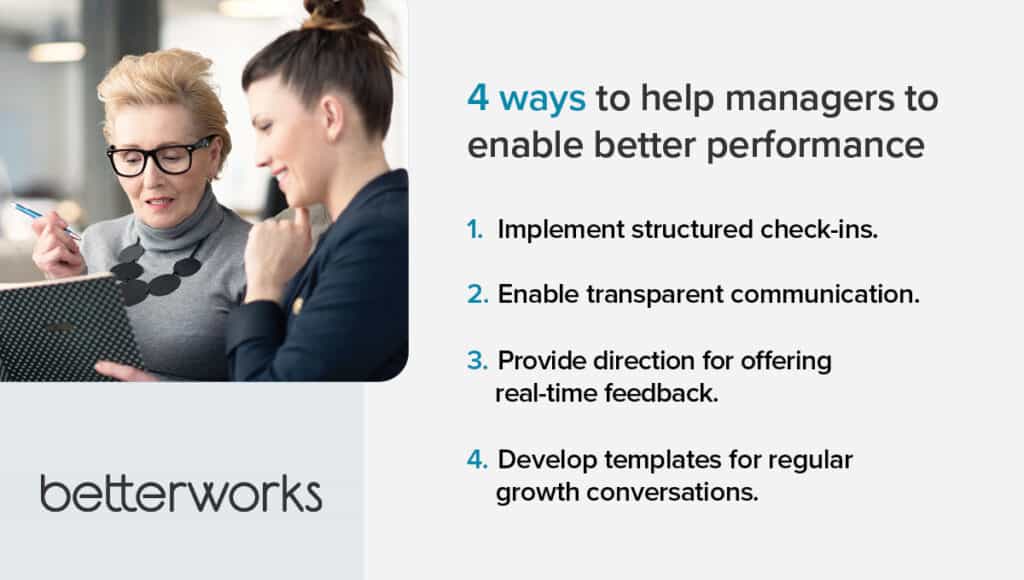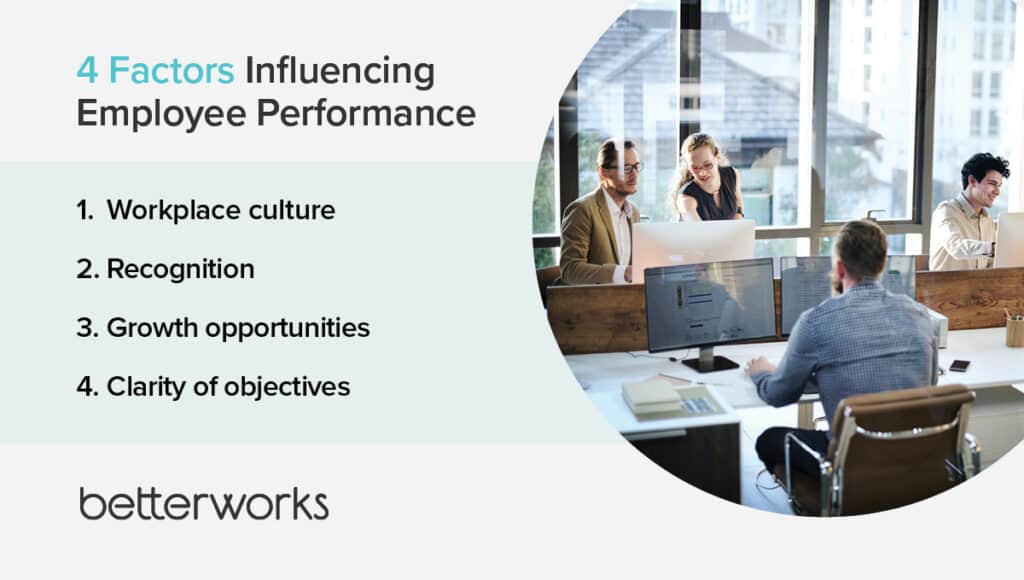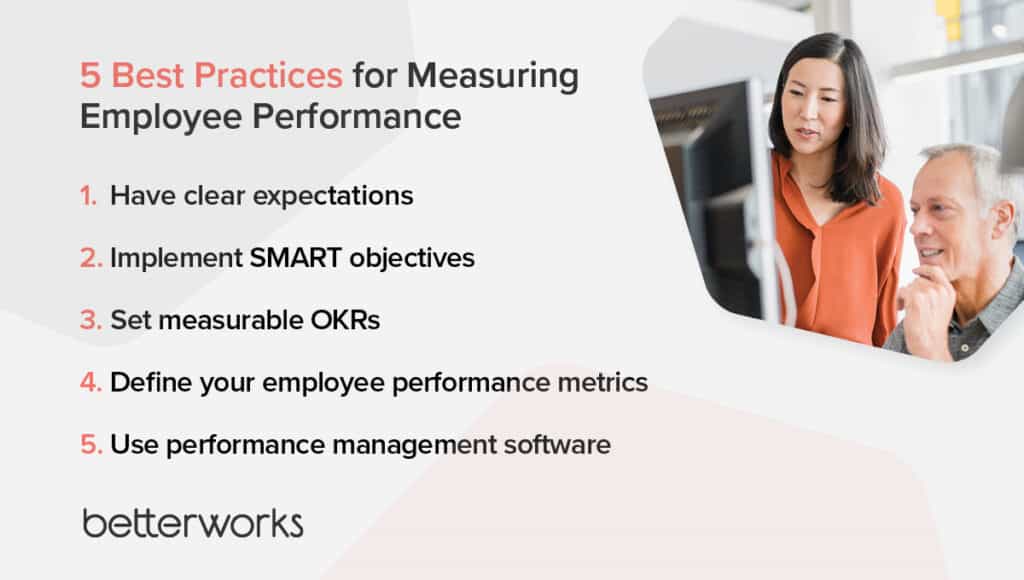Effectively managing employee performance has stumped employers for decades, and nailing down the right approach in a constantly changing world has proven to be even more challenging.
As an HR leader, you play an essential role in developing effective performance management processes, setting them in the proper organizational context, and empowering managers with the resources they need to drive better performance.
While every organization will have its own approach, many elements of good performance management are constant. Use our guide to managing employee performance to learn what’s most important for your organization.
Why is performance management important?
Left unmanaged, employee performance can be unpredictable, which means your business will be unpredictable. But by taking an active role in managing performance, you can provide clarity, direction, and purpose to empower your employees to be their best at work.
It’s important to distinguish between performance management today and legacy performance management processes. Older processes were incomplete and focused on a backward-looking annual review process. Modern approaches to performance management seek to align efforts with organizational goals and develop each employee’s potential in real time. These processes focus on enabling performance.
The unrelenting pace of change in today’s workplace calls for a versatile and resilient workforce. Performance enablement empowers employees to contribute their best, learn every day, and drive business impact.
4 ways to help managers to enable better performance
Direct managers are the key to unlocking each team member’s potential. Yet one-third of employees we surveyed for our State of Performance Enablement research report revealed that they don’t have one-on-one check-ins to discuss feedback and growth more than twice per year. And 10% of employees said they rarely or never receive actionable feedback from their direct managers.
For the organizations where those employees work, the need is simple: Prioritize feedback, and train managers to harness the power of communication and feedback to empower better performance. You can help managers in this pursuit in four key ways.

Implement a regular check-in processes
Managers are often an employee’s primary point of contact within the business, especially in hybrid and remote working environments. Regular and frequent check-in processes help managers and team members stay connected and build relationships. Structured conversations, which are scheduled and follow a question template, are part of an established performance management practice. ‘Anytime conversations’ are less formal and can resolve urgent needs or provide additional guidance.
Define the frequency for these check-ins, even as you let managers and employees figure out exact times and agendas. Weekly check-ins empower employees to receive feedback, ask questions, and raise concerns early.
Consider using performance management software that integrates with the software managers already use daily. For example, integrating check-ins within the manager’s calendar or task management software can help them stay on track and make these check-ins a habit rather than an afterthought
Enable transparent communication
To empower employee performance means enabling two-way communication between employees and managers. Create channels where employees can reach out to managers and receive guidance.
An employee may receive a last-minute assignment, for example, and need help prioritizing or redistributing their workload. They need to be able to access their manager to get that help. Slack, Microsoft Teams, or your task management software’s chat feature are good options. The organization’s role is to clearly communicate the needs and set expectations, so managers and employees know where to turn.

Provide direction for offering feedback in the flow of work
Real-time feedback is essential to good performance management, but many managers don’t feel equipped to offer it. They need training to recognize when an employee is struggling with their tasks and how to proactively address such performance rather than ignoring it or bringing it up much later.
When employees get feedback in the form of coaching from managers in the flow of work, they can adjust their behavior and mindset. This exchange can build trust because employees see their managers want to help them improve. Moreover, employees aren’t surprised by feedback that only arrives weeks or months later.
Provide conversation prompts to get managers started. Opening a conversation about a performance problem is often the most challenging part; prompts can give managers the confidence they need to create that dialogue. Train managers to ask questions that diagnose a problem’s cause and listen when employees express concerns about tasks or processes.
Develop templates for regular growth conversations
The annual review epitomizes the traditional performance management process. The manager typically dominated these reviews and looked backward rather than forward. Modern-day performance management considers past behavior, but it is a more frequent and collaborative process between manager and employee. Modern performance conversations aim to determine how best to empower each team member and push toward achieving high-priority business goals, as opposed to measuring past work and “grading” or ranking employees.
Performance enablement conversations are nuanced and require thoughtfulness and tact. They aren’t easy to have, and many managers haven’t been trained to conduct effective performance conversations. HR leaders can provide performance review templates outlining when managers should have formal growth conversations (at least once a quarter is recommended) and prompts for asking the right questions.
Include prompts for employee self-assessments, too. Employees have unique insight into their performance, strengths, and weaknesses. The right software can help managers securely collect this information from employees and use it to begin safe, forward-looking conversations.
Build templates into your performance management software so managers can access updated prompts and record conversation highlights to inform future meetings.

What influences employee performance?
There’s more to managing performance than changing how managers and employees interact. Several other factors influence individual employee performance at the structural level.
Workplace culture
Your workplace culture influences every aspect of the employee experience, including performance management.
Culture is what your organization values, prioritizes, and rewards. If employees feel that your organization values being visible in the office, they’re more likely to spend more time in the office — even if that doesn’t improve their performance.
On the other hand, empowering employee growth and development signals that you value each employee’s contributions and outcomes and want to invest in their potential.
Keep in mind that organizational culture isn’t monolithic. Different departments, teams, and locations might have their own micro-cultures, each with their own norms and values.
Recognition
Recognition is a key part of a good performance management program. Acknowledging and appreciating each employee’s good work and the value they drive for the business gives each team member confidence and pride. This can elevate morale and, in turn, lead employees to invest even more in improving their performance.
Implement recognition at the organizational level by incorporating it into check-in structures. One way to do this is by including shout-outs during team and all-hands meetings and encouraging individuals to recognize each other, too.

Growth opportunities
The ability to progress and grow can be a powerful performance motivator. When employees feel supported in their career and development goals, they’ll be more likely to engage with their work and perform at a higher level.
Consider building a talent marketplace to empower internal mobility. This allows you to communicate opportunities to team members, catalog the skills you have within your workforce, and help employees determine how they need to grow to reach their professional goals.
Clarity of objectives
At the highest level, good objectives start with the business strategy. To align goals across the organization, the leadership team has to set clear objectives and make the business priorities clear.
With HR’s guidance, department heads can then take these objectives to their teams and collaborate to determine how they can drive the business forward. This alignment process continues until managers can take their team’s objectives and work with employees to set individual goals. This alignment process won’t stay on track unless you have clear objectives in the first place.

5 best practices for measuring the performance of employees
You won’t know that performance is improving unless you track it using clear metrics. Use these best practices to ensure you’re tracking the right information.
Have clear expectations
The strongest measure of performance is whether employees are achieving performance expectations (i.e., outcomes). However, misalignment between what managers expect from employees and what they think they deliver can skew your results. Make sure managers and employees are on the same page with performance expectations.
Implement SMART goals
SMART goals are specific, measurable, achievable, relevant, and time-bound. Setting objectives that check each box makes tracking their progress much easier. Have employees clearly state their goals and the specific actions they plan to take to achieve them.
Set measurable OKRs
Objectives and key results are a goal-setting framework that clarifies what you’re trying to achieve and outlines how you’ll know you’ve succeeded. Key results are required events, outcomes, or milestones that indicate progress toward objectives. Finding the right key results for each objective creates a more transparent performance measurement process.
Define your employee performance metrics
Metrics cover qualitative and quantitative measures that managers and employees have agreed upon for measuring performance against expectations. These metrics will look different across organizations and job roles. Generally, employee performance metrics can indicate work efficiency, the number of errors made (or saved), or the revenue driven by each employee. Be transparent about what you’re tracking and how you’ll measure it.
Adopt modern performance management tools and software
Data generated by performance appraisals and metrics can be challenging to collect and evaluate manually. Performance management software can streamline and automate data collection and inform analysis over time. Ideally, you can see where performance is improving, stagnating, or declining without waiting until the evaluation period ends. Templates and prompts within your performance management software can help managers understand performance data and make informed inferences.

3 performance management scenario examples
What does modern performance management look like in practice? These scenarios demonstrate how to apply sound performance management principles in practice.
Managing a remote sales team
Consider how sales leaders have adapted to manage remote teams. As the day-to-day sales environment has changed, so must performance management. You’ve likely updated your outbound sales training to account for an increase in video sales meetings. Likewise, onboarding processes should include online modules, and performance conversations should accommodate phone and video calls.
Remote sales teams have had to communicate more in a virtual environment, which has likely been a significant change for reps who historically met with prospects in person. The sales manager plays a key role in shifting sales processes and managing remote workers, but they also need support from HR leaders and software. Amidst these changes, maintaining a focus on sales productivity becomes crucial for the overall success of remote sales teams.
Managing a hybrid call center team
Hybrid teams are becoming more common, which can add complexity to performance management. Fairly managing performance with a hybrid team can be challenging for managers, especially when it’s a new process. In these scenarios, it’s even more important to manage employees by objectives to avoid giving preference to people based on whether or how often they’re in the office (i.e., proximity bias).
For a hybrid call center team, for example, managing by objectives could mean focusing on metrics like time to resolution or the number of calls needed for resolution. Those metrics focus on outcomes and customer satisfaction — factors within each employee’s control. Regularly scheduled check-ins are also important to provide every employee with feedback and development.
Call center employees working from central job sites might have greater visibility into growth opportunities if HR leaders and managers aren’t careful. Make sure that growth opportunities are easily visible across the organization — ideally, in a centralized place every employee can access without needing to be on-site.
Managing a cross-functional team
Cross-functional teams can be challenging to manage because team members are in new environments, with new teammates and, in many cases, managers they haven’t worked with.
Cross-functional team leaders must focus on performance outcomes. It’s even more important for managers to be clear about what they expect from each employee and how they’ll measure performance, especially across job responsibilities and functions. Develop prompts and other resources that help managers communicate performance expectations and fairly measure them while accounting for each employee’s circumstances.
Fostering great employee work performance
Managing employee performance is an ongoing lesson in communication, planning, feedback, and growth. That’s why HR leaders have such an essential role in creating the infrastructure that empowers managers to keep abreast of what their employees are doing, remove roadblocks, and help employees reach their full potential. When employees feel supported in their roles and are encouraged to seek out growth opportunities, they can optimize their performance to drive business results.
Learn how to improve employee performance.


